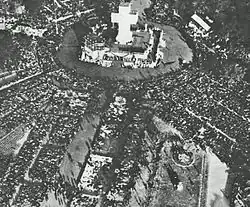Mariano de Vedia y Mitre
Mariano de Vedia y Mitre | |
|---|---|
 Vedia y Mitre in 1933 | |
| Mayor of Buenos Aires | |
| In office 19 September 1932 – 19 February 1938 | |
| President | Agustín P. Justo |
| Preceded by | Rómulo S. Naón |
| Succeeded by | Arturo Goyeneche |
| Personal details | |
| Born | 29 December 1880 Buenos Aires, Argentina |
| Died | 19 February 1958 (aged 77) Montevideo, Uruguay |
| Political party | National Democratic Party |
| Spouse | Helena Caronti[1] |
| Alma mater | University of Buenos Aires |
Mariano de Vedia y Mitre (29 December 1880 – 19 February 1958) was an Argentine lawyer, writer, historian, and politician who served as intendente (mayor) of the City of Buenos Aires from 1932 to 1938, appointed by President Agustín P. Justo. His tenure was marked by major public works but also marred by the CHADE Scandal, a corruption case involving fraudulent electricity concessions.
Early life and career
Born on 29 December 1880 into a prominent Buenos Aires family. His father, also named Mariano, was governor of Corrientes and served as a national deputy, while his maternal grandfather, Bartolomé Mitre, was one of the leading figures of Argentina's 19th century history and served as president from 1962 to 1968. On his paternal side he was a descendant of Juan Martín de Pueyrredón, an early leader of Independence-era Argentina.[2]
Vedia y Mitre earned his law degree from the University of Buenos Aires (UBA), where he later taught Constitutional Law and Political Law. He also lectured at the Escuela Superior de Guerra and several secondary schools.
His judicial career included roles as a civil and criminal prosecutor in Buenos Aires, judge, and member of the Court of Appeals. He was affiliated with elite social clubs such as the Jockey Club,[3] Club del Progreso and Círculo de Armas.
Political career
On 19 September 1933, Vedia y Mitre was appointed as Mayor of Buenos Aires by President Agustín P. Justo. Vedia y Mitre's six-year administration oversaw unprecedented urban transformation in Buenos Aires. His most visible legacy remains the radical modernization of the city's infrastructure, beginning with the monumental widening of Avenida Corrientes. This ambitious vision extended to healthcare infrastructure with the construction of Hospital Argerich and the foundational work on Hospital Fernández.[4]
The administration's most enduring symbols emerged along the new Avenida 9 de Julio, where Vedia y Mitre inaugurated the Obelisco in 1936 as a centerpiece of Argentina's quadricentennial celebrations.[5] Nearby, Plaza San Martín underwent significant expansion through the controversial demolition of historic buildings along Alem Avenue cliffside, creating the park's current expansive layout. Simultaneously, major engineering projects progressed, including the enclosure of the Maldonado Stream to create Avenida Juan B. Justo and the initial phases of the Costanera Norte coastal highway.[6]

These transformations occurred alongside significant cultural events that defined 1930s Buenos Aires. The city hosted the 1934 International Eucharistic Congress, marked by massive religious processions along Avenida del Libertador and the installation of monumental crosses on the under-construction Kavanagh Building. That same year, the visit of the Graf Zeppelin airship captured global attention, showcasing Buenos Aires as a modern metropolis.[7]
However, this period of progress was overshadowed by the CHADE scandal, where Vedia y Mitre's controversial extension of electricity concessions (effectively granting private companies 90-year monopolies by negating reversion clauses) exposed systemic corruption involving bribes to municipal and national officials.[8] This scandal would later become emblematic of the corporate-political collusion during Argentina's Infamous Decade.[9]
Later life and death
On 19 February 1938, President Justo stepped down and was replaced by Roberto Marcelino Ortiz, who appointed a new mayor for Buenos Aires, Arturo Goyeneche.[10][11]
Vedia y Mitre died in Montevideo, Uruguay, on 19 February 1958. His remains were interred at La Recoleta Cemetery in the Caronti family mausoleum; in 1972 the entire family were exhumed and moved to Bahía Blanca, where they remain to this day.[1]
References
- ^ a b "Mariano de Vedia y Mitre". La Nueva (in Spanish). 21 February 2021. Retrieved 15 July 2025.
- ^ Zandonadi, Gustavo (20 February 2024). "Mariano de Vedia y Mitre, el intendente que ensanchó la calle Corrientes y transformó Buenos Aires". Agencia Nova (in Spanish). Retrieved 15 July 2025.
- ^ "La Historia de la Biblioteca del Jockey Club". jockeyclub.com.ar (in Spanish). Retrieved 15 July 2025.
- ^ Colombo, Susana (7 April 1996). "¿Qué intendente necesita Buenos Aires?". Clarín (in Spanish). Archived from the original on 4 March 2016.
- ^ Pignatelli, Adrián (23 May 2023). "El Obelisco cumple 87 años: la historia del monumento que fue construido donde se izó por primera vez la bandera argentina". Infobae (in Spanish). Retrieved 14 July 2025.
- ^ Gruschetsky, Valeria (11 August 2017). El sistema de avenidas de la ciudad de Buenos Aires en la era de los automotores (1920-1940) (PDF). XVI Jornadas Interescuelas/Departamentos de Historia (in Spanish). Mar del Plata: Facultad de Humanidades, Universidad Nacional de Mar del Plata. Retrieved 15 July 2025.
- ^ Bauso, Matías (30 June 2019). "El día que una gigantesca nave cruzó el cielo de Buenos Aires". Infobae (in Spanish). Retrieved 15 July 2025.
- ^ Lanata, Jorge (2003). "Una luz entre las sombras". Argentinos: Quinientos años entre el Cielo y el Infierno (in Spanish). Buenos Aires: Sudamericana. ISBN 9789500730020.
- ^ Pigna, Felipe. "Los negociados de la década infame". El Historiador (in Spanish). Retrieved 15 July 2025.
- ^ Yaverovski, Alejandro Martín (June 2021). "Tres Repúblicas Barriales y sus Universidades. Las Universidades Populares en la ciudad de Buenos Aires en el período de entreguerras: un esquema preliminar" [Three Neighborhood Republics and their Universities. People's Universities in the city of Buenos Aires in the interwar period: a preliminary outline]. Historia Caribe (in Spanish). 16 (38). Barranquilla: University of Atlántico: 35-80. doi:10.15648/hc.38.2021.2817. ISSN 0122-8803.
- ^ del Corro, Fernando (29 December 2011). "Hace 75 años se consumó el negociado de la Chade". Ámbito Financiero (in Spanish). Retrieved 15 July 2025.